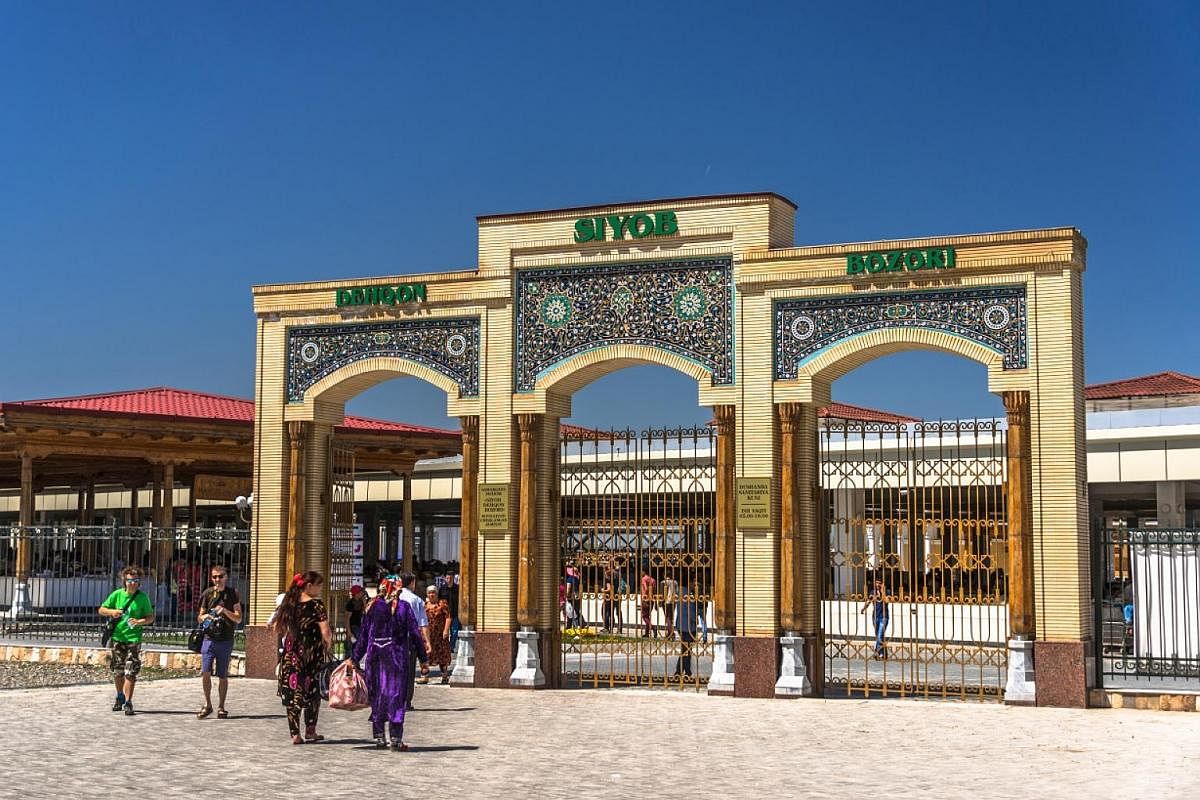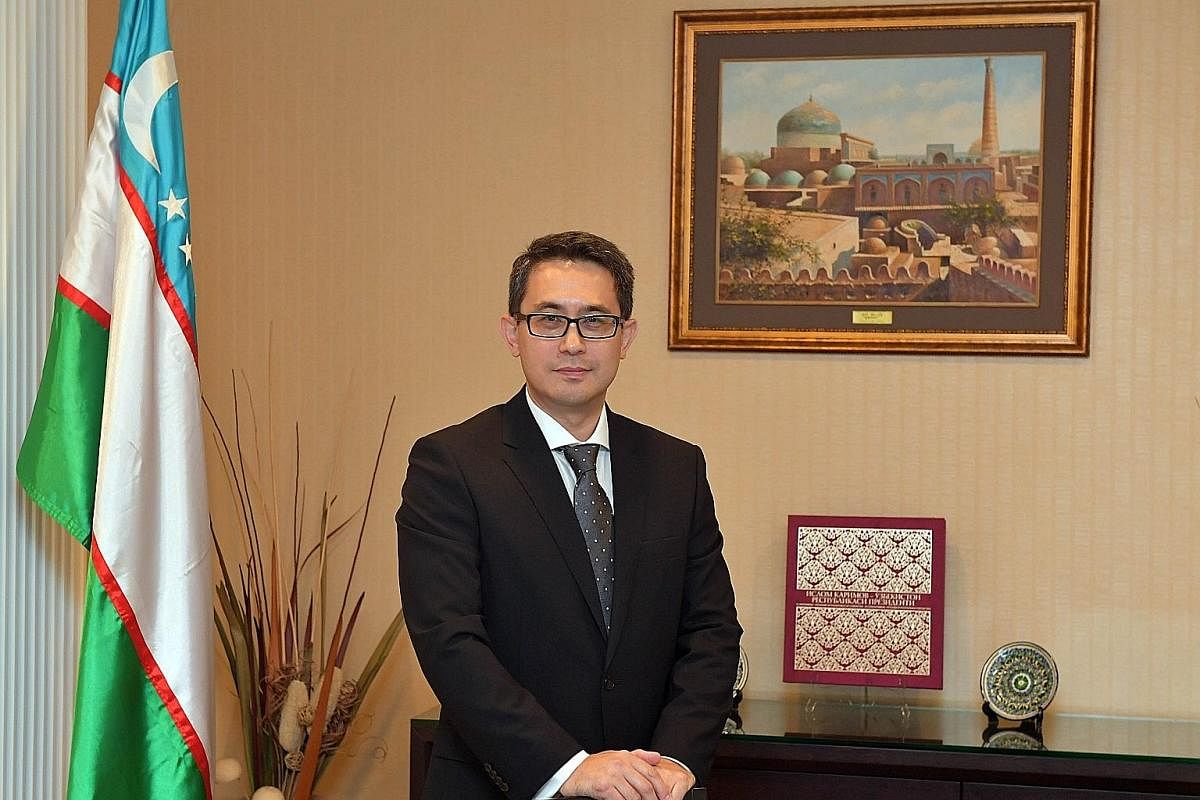-

-
GETTING THERE
Uzbekistan Airways operates a direct service between Singapore and Tashkent on Wednesdays and via Kuala Lumpur on Fridays.
Uzbekistan has a good rail network and trains are the ideal way to travel between Tashkent and Samarkand. The high-speed rail line covers the 344km distance between the two cities in about two hours. -
TIPS
• Travellers should take four to five days to explore Samarkand and the surrounding valley.
• Uzbekistan is safe. Occasionally, police may ask to see your documents - to prevent security threats - so it is a good idea to carry a colour photocopy of your passport with you.
• The best time to visit is in spring, summer or autumn as Samarkand winters are very cold and temperatures often drop to below 0 deg C.
Travel Black Book: Ambassadors series
Uzbekistan's Samarkand: Oasis nestled in tradition
The best of home: Ambassadors to Singapore provide an insider's guide to their favourite destinations


Who: Mr Aziz Masutov, 45, Ambassador of Uzbekistan to Singapore
Favourite destination: Samarkand, the second largest city after the capital Tashkent, is located in the majestic Zarafshan Valley. The city, which poets and historians have called "the precious jewel of the Eastern world", is a must-visit for any traveller to Central Asia.
It is one of the most ancient cities in the world and, in 2007, celebrated its 2,750th anniversary. Like other centres of human civilisation such as Babylon, Alexandria, Athens and Rome, Samarkand has lived through many historical events and upheavals.
For many years, it was a vital and cosmopolitan centre on the Silk Road. The major trade routes to Persia in the west, China in the east and India in the south intersected here, which made it a target for invasions. Alexander the Great and Genghis Khan brought their troops to the city gates and, in 1370, Samarkand became the capital city of the Timurid dynasty.
Samarkand is built upon these influences and has retained much of its unique architecture and ancient monuments, as well as carefully preserved ancient craft traditions such as gold embroidery, silk-weaving, copper-engraving, carving and ceramics.
For its unique spirit of antiquity, heritage and cultural preservation, Unesco added the city to its World Heritage List as a Crossroad of Cultures in 2001.
SEE
The cultural core of Samarkand is the Registan Ensemble, a huge public square surrounded on three sides by religious complexes of mosques and madrasahs. It was once the main city square filled with markets and surrounded by caravanserai (roadside inns).
The Arab proverb, "If you want to understand us, examine our monuments", adorns one of the buildings. Built at different times between 1370 and 1500 by members of the Timurid dynasty, these monuments have ornate and towering portals, twin minarets, thousands of blue tiles and intricately carved marble.
Other notable historical sites include the Gur-e-Amir Mausoleum, which is the mausoleum and family crypt of the Timurid dynasty that ruled the area from 1370 to 1507; Bibi-Khanym Mosque, one of the largest and most beautiful mosques in the world when it was built in the early 15th century; Mausoleum of Prophet St Daniel, containing relics of the Old Testament biblical prophet; and the Ulugh Beg Observatory, which was built in the 1420s and is considered one of the finest observatories in the Muslim world.
Samarkand sits in an oasis created by the Zarafshan River, which means "gold bearing" in Persian, and is the gateway to the Zarafshan valley. The valley and surrounding mountains are a must-visit for anyone who wants to experience the surviving remnants of the Silk Road.
EAT
There are many restaurants serving traditional Uzbek and eastern European food.
Platan (Pushkin Street, 2), said to be the city's best restaurant, serves Uzbek classics and has a nice outdoor terrace. Restaurant Samarkand (Mahmuda Koshgari, 54) boasts ornate halls and dance performances.
A popular local restaurant is Karimbek (Gargarina Street, 194), which has great shashlik. Zlata Praha (Mirzo Mlugbeka, 59) is two restaurants under one roof, so guests can choose between traditional Uzbek food on one level and European fare on the other.
Traditional Uzbek food consists mainly of meat - mostly mutton - rice, milk and vegetables. Plov, or palov, is the national dish, a main course of meat with grated carrots, onions and rice cooked in a pot over an open fire.
There are more than 100 varieties of this dish - each family, restaurant or region makes it a different way, sometimes adding chickpeas, raisins or other fruit and spices to it. You can find plov in most restaurants, where it will cost about US$4 (S$5.60) or US$5.60 a dish.
In Uzbekistan, bread is considered sacred. Each region and occasion has its own style and decoration of bread loaves, although most of them are flat breads called non (pronounced naan), lepeshkas and patyr, which are baked in a tandyr (clay oven).
There are many Uzbek customs and age-old traditions related to bread. Uzbek people present bread as a gift when visiting family and friends, for example, and it is always torn by hand, never cut with a knife. Also, placing it other than flat side down is considered disrespectful.
Samarkand bread is famous for its flavour and, when you break the bread, which has been made in the same way with the same recipe for centuries, it is as though you are holding the history of the ancient city in your hands.
Uzbekistan is also famous for its sweet, juicy fruit - melons, gourds, grapes, apricots, peaches, pears, apples and figs.
SHOP
My favourite place for shopping is Siab Bazaar. Located near the Registan Ensemble, its entrance is a high trifold arch decorated with dark blue mosaic tiles.
The best time to visit is in the summer and early autumn, when the market is full of the best produce: colourful fruit, berries, vegetables, cereals and salad greens.
The 5ha market is divided into sections, which include vegetables; nuts; and dried fruit such as raisins, currants, dried apricots and salted cracked apricot pits baked in ash; and Asian sweets such as navat (grape sugar crystals), kazinaki (pressed nuts or seeds with sugar or honey), parvarda (white hard candies) and pashmak (mass of thin sugar threads).
It is also the best place to buy spices such as cinnamon, nutmeg, cardamom, cloves, sesame seeds and dried ground tomatoes.
In the cereals section, you will find barchans (crescent-shaped dunes) of rice, mung beans, wheat, millet, barley and various grains for poultry and pet birds.
You will also find bread, of course, and you will rarely find a visitor to Samarkand leaving without non as a gift for friends and family.
It is an ideal souvenir because it keeps for a long time. Real Samarkand bread does not go stale and will stay edible for three years. Before eating, sprinkle the bread with water and warm it up in an oven.
PLAY
Once every two years, Samarkand's International Music Festival, or Sharq taronalari (sharqtaronalari. uz), brings together some of the best traditional music from around the world.
Under the patronage of Unesco, the festival's goal is to promote and preserve traditional musical and vocal arts, as well as encourage cultural exchange and the pursuit of traditional music among the young.
More than 65 countries, including Singapore, participated in the last festival in 2015.
The next edition will take place this year from Aug 25 to 30.
STAY
If you want luxury, stay in hotels such as the Registan Plaza (www.registan-plaza.com) and the Hotel Grand Samarkand Superior (www.grand-samarkand.com).
Smaller hotels such as Hotel Malika Prime (www.malika-samarkand.com) and Hotel Bibikhanum (www.hotel-bibikhanum.com) boast a local flavour.
Join ST's Telegram channel and get the latest breaking news delivered to you.
A version of this article appeared in the print edition of The Sunday Times on May 14, 2017, with the headline Uzbekistan's Samarkand: Oasis nestled in tradition. Subscribe

